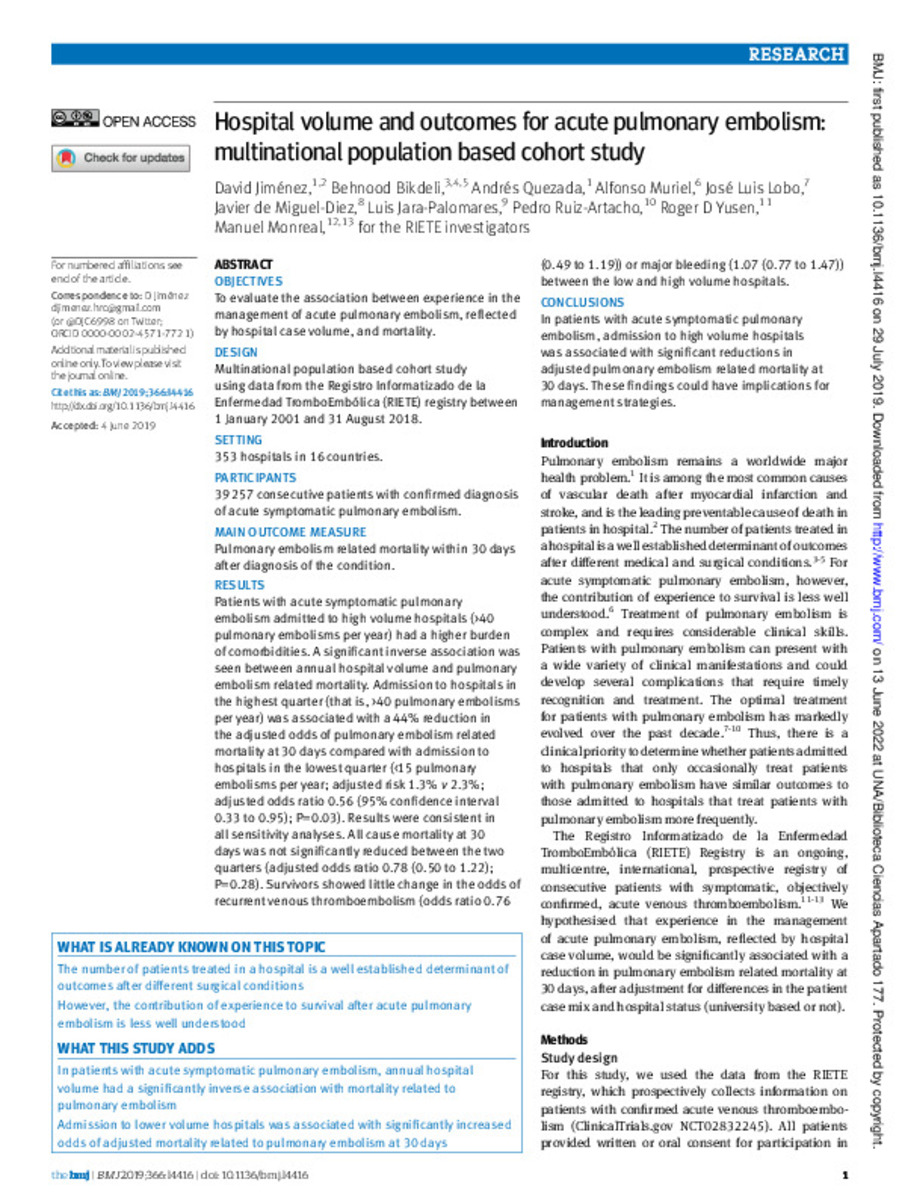Full metadata record
| DC Field | Value | Language |
|---|---|---|
| dc.creator | Jiménez, D. (David) | - |
| dc.creator | Bikdeli, B. (Behnood) | - |
| dc.creator | Quezada, A. (Andrés) | - |
| dc.creator | Muriel, A. (Alfonso) | - |
| dc.creator | Lobo, J.L. (José Luis) | - |
| dc.creator | Miguel-Diez, J. (Javier) de | - |
| dc.creator | Jara-Palomares, L. (Luis) | - |
| dc.creator | Ruiz-Artacho, P. (Pedro) | - |
| dc.creator | Yusen, R.D. (Roger D.) | - |
| dc.creator | Monreal, M. (Manuel) | - |
| dc.date.accessioned | 2022-06-14T06:44:51Z | - |
| dc.date.available | 2022-06-14T06:44:51Z | - |
| dc.date.issued | 2019 | - |
| dc.identifier.citation | Jiménez, D. (David); Bikdeli, B. (Behnood); Quezada, A. (Andrés); et al. "Hospital volume and outcomes for acute pulmonary embolism: multinational population based cohort study". BMJ. 366, 2019, 14416 | es |
| dc.identifier.issn | 0959-8138 | - |
| dc.identifier.uri | https://hdl.handle.net/10171/63642 | - |
| dc.description.abstract | Objectives To evaluate the association between experience in the management of acute pulmonary embolism, reflected by hospital case volume, and mortality. Design Multinational population based cohort study using data from the Registro Informatizado de la Enfermedad TromboEmbólica (RIETE) registry between 1 January 2001 and 31 August 2018. Setting 353 hospitals in 16 countries. Participants 39 257 consecutive patients with confirmed diagnosis of acute symptomatic pulmonary embolism. Main outcome measure Pulmonary embolism related mortality within 30 days after diagnosis of the condition. Results Patients with acute symptomatic pulmonary embolism admitted to high volume hospitals (>40 pulmonary embolisms per year) had a higher burden of comorbidities. A significant inverse association was seen between annual hospital volume and pulmonary embolism related mortality. Admission to hospitals in the highest quarter (that is, >40 pulmonary embolisms per year) was associated with a 44% reduction in the adjusted odds of pulmonary embolism related mortality at 30 days compared with admission to hospitals in the lowest quarter (<15 pulmonary embolisms per year; adjusted risk 1.3% v 2.3%; adjusted odds ratio 0.56 (95% confidence interval 0.33 to 0.95); P=0.03). Results were consistent in all sensitivity analyses. All cause mortality at 30 days was not significantly reduced between the two quarters (adjusted odds ratio 0.78 (0.50 to 1.22); P=0.28). Survivors showed little change in the odds of recurrent venous thromboembolism (odds ratio 0.76 (0.49 to 1.19)) or major bleeding (1.07 (0.77 to 1.47)) between the low and high volume hospitals. Conclusions In patients with acute symptomatic pulmonary embolism, admission to high volume hospitals was associated with significant reductions in adjusted pulmonary embolism related mortality at 30 days. These findings could have implications for management strategies. | es_ES |
| dc.language.iso | eng | es_ES |
| dc.publisher | BMJ | es_ES |
| dc.rights | info:eu-repo/semantics/openAccess | es_ES |
| dc.subject | Acute symptomatic pulmonary embolism | es_ES |
| dc.subject | High volume hospitals | es_ES |
| dc.subject | Mortality | es_ES |
| dc.title | Hospital volume and outcomes for acute pulmonary embolism: multinational population based cohort study | es_ES |
| dc.type | info:eu-repo/semantics/article | es_ES |
| dc.description.note | This is an Open Access article distributed in accordance with the Creative Commons Attribution Non Commercial (CC BY-NC 4.0) license, which permits others to distribute, remix, adapt, build upon this work non-commercially, and license their derivative works on different terms, provided the original work is properly cited and the use is noncommercial. See: http://creativecommons.org/licenses/by-nc/4.0/. | es_ES |
| dc.identifier.doi | 10.1136/bmj.l4416 | - |
| dadun.citation.publicationName | BMJ | es_ES |
| dadun.citation.startingPage | 14416 | es_ES |
| dadun.citation.volume | 366 | es_ES |
Files in This Item:
Statistics and impact
Items in Dadun are protected by copyright, with all rights reserved, unless otherwise indicated.






